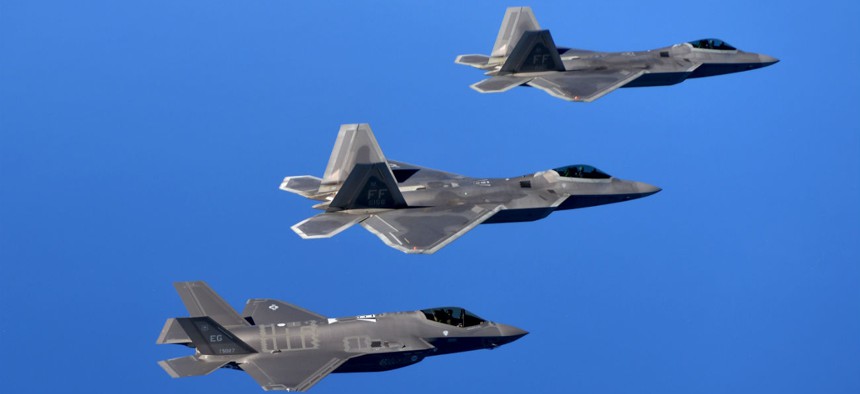
F-22 Raptors from the 94th Fighter Squadron, Joint Base Langley-Eustis, Va., and F-35A Lightning IIs from the 58th Fighter Squadron, Eglin Air Force Base, Fla., fly in formation after completing an integration training mission. Master Sgt. Shane A. Cuomo / U.S. Air Force file photo
At Long Last, the F-35 and F-22 Might Talk to Each Other
And once service officials can digitally link two of the military’s stealthiest platforms, they’re going to try to link everything else.
The U.S. Air Force will try to get an F-22 and an F-35 to talk to each other in December, part of a broader effort to link all of its manned and unmanned aircraft, Air Force and military officials announced on Thursday. The service is also testing a new dashboard to help commanders and operators share a picture of the battlefield that shows all ground, air, sea, and even cyber assets.
“We’ve got a variety of platforms we would like to be able to share information in ways they haven’t done before,” Preston Dunlap, who was named the Air Force’s first chief architect in March, told attendees at Defense One’s Outlook 2020 conference on Thursday.
It’s part of the Pentagon’s vision to digitally link operations in every warfighting domain, including every ship, aircraft, vehicle, and servicemember in the Army, Navy, Marines, and Air Force, a concept that service chiefs first began discussing publicly in 2017.
There are multiple challenges to realizing that vision. A big one is that many of the military’s expensive jets and other platforms weren’t designed for that sort of digital integration. Hence the test to connect and F-22 and an F-35 over a digital gateway — essentially, software that translates between the planes’ different communications protocols and radio frequencies.
“We built the F-22 a while ago,” said Dunlap. “Time passed.”
He described the F-35 as better technology but with “a different set of communication standards. So that’s both physics, like frequency, and software, and radio, and what’s behind that antenna.
“In December, we have an ambitious goal where, for the first time, we want to be able to share data as we would like to in a relevant type of environment that you would want to operate in, say a highly contested type of environment. That means you want for it to be hard to be detected in that type of environment. You want to make sure that the message gets from one place to another with some type of assurity,” he said. “The main point is that we want both of them to be able to share communication over a link that allows them to do so in a way that protects their survivability.”
Part of the challenge is figuring out what precisely an F-22 and F-35 should say to each other, and what pilots and their commanders should do with that information. It’s not just a semantic quandary. The multirole F-35 was designed to integrate lots of data from various other sensors and drones across the battlefield; the F-22, designed primarily for air dominance, was not. Each pilot’s view of the battlefield and everything in it is very different.
The jet-to-jet communications architecture — to be developed and tested in four-month cycles — will ultimately lay the foundation for the Air Force’s connections to other platforms, like ships, tanks, trucks, and troops. “We’re going to extend that to our sister services so that that information can be shared with troops on the ground,” said Dunlap. “So if its an Army unit, Marines, or Special Operations, they can really take advantage of information from aircraft or satellites overhead, but today are fairly limited in information they can get to.”
This change in connectivity will require new tactics, techniques, and concepts of operations. So far, the service’s efforts to meet that need deserve a B grade, Air Force Brig. Gen. David Kumashiro said at the Outlook 2020 conference. Greater interconnectedness across jets, other platforms, and operators will create ripple effects across different areas of military activity, said Kumashiro, the director of Joint Force Integration and the Deputy Chief of Staff for Strategy, Integration and Requirements. For instance, future combined air operations centers, or CAOCs, won’t be as limited to a specific geographic location. Instead, a lot more people would be participating in CAOC activities from around the world. That would allow commanders to bring in different specialists or experts to figure out the best course of action.
Next month, the Air Force will create Omni One, a dashboard that will present an integrated picture of various U.S. military assets, like jets, tanks, and ships. It’s the sort of thing that civilians are used to when they use apps like Waze or FlightAware but that doesn’t exist in the military for most operators, particularly those in very hard-to-reach places. Omni One is meant to provide the same picture that commanders have at the highest levels down to every operator that needs that view.
“You can know, see a picture, you can click on a ship and where it’s been, where it’s traveling, what’s on the ship,” Dunlap said. That’s the kind of thing that we’re used to and is readily available and we need to be able to get that to our warfighters in a way that’s accessible. Having to go behind eight closed doors to go get that is a difficult sort of thing if you want to bring people together.”
NEXT STORY: The Air Force’s ‘Doomsday Plane’ Is in the Shop







